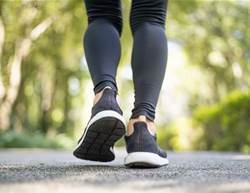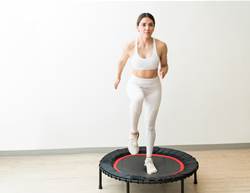- New research found that people who exercised regularly were better able to handle a pain test.
- The researchers say this suggests exercise may help those with chronic pain.
- Doctors say there are a few reasons why exercise may help build your pain tolerance.
While pain is part of life, it’s not exactly something people are eager to experience. Now, new research suggests doing something as simple as exercising regularly may help boost your pain tolerance.
Around 3.6 million Australians experience chronic pain, and it's our leading cause of disability. So new pain research could have a big impact.
The study, which was published in Plos ONE, used data from 10,732 adults in Norway and analysed their self-reported activity levels, along with their pain tolerance.
Pain tolerance was measured by having people rank their pain on a scale when their hands were submerged in ice water. The study participants were surveyed two times, with about an eight-year gap in between.
The researchers found that study participants who reported having higher levels of physical activity were more tolerant to pain. That was able to change with time—the researchers found that the capacity for pain tolerance increased the more people said they exercised during the study period.
“These results support increased physical activity levels as a possible non-pharmacological pathway towards reducing or preventing chronic pain,” the researchers wrote in the conclusion.
Pain management is complicated and there’s a lot experts don’t know about what, exactly, causes pain. So, can working out regularly help? Here’s the deal.
Why can regular exercise help with pain tolerance?
This isn’t the first study to link pain tolerance with exercise. An older study published in the British Journal of Sports Medicine found that people had a “significantly higher” pain threshold five minutes after doing a resistance exercise routine.
The latest study didn’t explore why people who exercise regularly seem to have a higher pain tolerance—it merely found a link. However, this is something that doctors say they see in patients as well.
“Clinically, we notice that physical activity in chronic pain patients tends to improve their pain tolerance and decrease their pain,” says pain management specialist Dr Medhat Mikhael.
Dr Mikhael says are a few theories on why this might be the case. One is that physical activity usually increases your heart rate, which ramps up levels of the feel-good hormone serotonin in your body.
“Physical activity also can cause changes in the higher processing centres in the brain and modulate pain,” Dr Mikhael says.
Regular movement can also help your body release endorphins, points out pain management expert Dr Haijun Zhang.
“Any muscle movement regularly will activate the brain to release endorphins, which are one of the most powerful internal peptides to treat pain,” he says. “They have a similar effect on the body to morphine—that’s why a lot of people feel good after exercise.”
Your immune system likely plays a role as well, according to physical therapy expert Adrienne H. Simonds.
“Our immune system normally releases substances called cytokines. There are pro-inflammatory and anti-inflammatory factors,” she explains.
“Exercise and physical activity promote the release of anti-inflammatory factors, such as IL-2, IL-4, IL-10, IL-13.”
Since those factors encourage your body to reduce its inflammatory response, “people who exercise regularly may experience less bodily pain and improved pain tolerance,” Simonds says.
“There is both a protective pain mechanism that comes with exercise, and it also encourages you to keep it up,” says Dr John Vasudevan, who specialises in physical medicine and rehabilitation.
Exercise can help lower chronic pain over time, too, by strengthening your muscles and reducing the burden on your back and joints, Dr Mikhael says.
What options do people currently have for chronic pain?
There are a lot of different treatment options available for chronic pain, and they can generally be divided into two camps: medical treatments (such as medications or injections) and complementary therapies.
Healthdirect reports "medicines alone are not the most effective way to treat chronic pain. It is best managed using a combination of different approaches."
Research has shown that some complementary therapies can help with chronic pain management, too. According to the National Center for Complementary an Integrative Health (NCCIH), those can include:
- Acupuncture
- Hypnosis
- Massage
- Mindfulness meditation
- Music-based interventions
- Tai chi
- Quigong
- Yoga
How to fit in exercise if you have pain
Dr Zhang says that any exercise is better than none if you have pain. “Our instruction for patients typically is to exercise as long as you can tolerate it,” he says. “Do an exercise routine daily. It doesn’t matter for how long.”
As for what, exactly to do, he recommends checking in with your doctor or physiotherapist. “All kinds of exercise can help,” Dr Zhang says. “But if you have shoulder problems, we may focus on the shoulder; someone with knee problems will focus on strengthening the knee.”
Other factors, including considering when to exercise, are important, Simonds says. “Time of day is important to consider when scheduling exercise for individuals with chronic pain and other comorbidities because often, at the end of the day, physical activity may become more challenging because of fatigue or pain levels,” she says.
“Therefore, scheduling physical activities earlier in the day when pain levels and fatigue are lower may improve participation in order to receive the health benefits.”
It also can be helpful to pair exercise with things people already enjoy. “Pairing exercise with daily activities and hobbies or interests can be a critically important strategy for individuals to get exercise throughout the day, rather than scheduling dedicated time with additional equipment and cost,” Simonds says.
“This strategy can also reduce resistance to exercise and improve motivation because it makes exercise easier to access.”
Overall, it’s important to personalise your workout routine to you. “Exercise works like any other medicine. It works with the proper dose, frequency, and type,” Dr Vasudevan says.
Dr Zhang says that even five minutes of exercise can help. “As you go along, you can increase the time if you can tolerate it,” he says.










